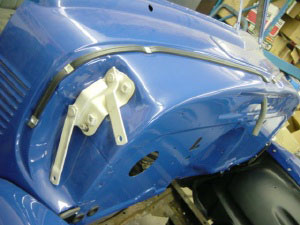The differences found on the cab during the beginning of the Advance Design years are subtle, yet on close study soon become quite evident. It probably exists on all vehicles when a body style is first introduced. Lab tests on a vehicle tend to overlook a few problems that later surface when it is in the hands of the consumer. Thus engineers made various corrections on the 1948 cab leaving the first year of this series with several unique differences.
Beginning with the Advance Design trucks in mid 1947, the top of the body cowl directly below the rear of the hood is smooth. This is the space between the rubber hood lace and vertical firewall panel. GM soon discovered that in this area an error in design existed. During heavy rain all water that flowed past the hood lace could run forward and then down the firewall. This allowed water on important items such as the voltage regulator, fuse box, wiring, fresh air heater motor, the rubber grommets that held tubes, lines and the original cotton braided wires.
By mid 1948, an appropriate stamping change was made which remained through the end of the series in early 1955. This was a groove or trough running side to side in the top of the cowl. These troughs drain rain water down the cowl sides onto the recessed area by the hood hinges and protect the firewall components. Now 50 to 55 years later we are noticing a rust condition due to these water drain troughs. Seldom will a 1947 cab have major rust in these hood hinge indentations. The cabs between 1948 and 1955 will usually be showing rust out or at least much surface rust when stored outside for many years. There is only so long this recessed area can resist the regular attack of water runoff from the troughs before it begins to show deterioration.

No water troughs
Another very noticeable feature on only the 1947 Advance Design cab is the lack of a hump in the lower part of the dash above the steering column. On 1948-1955 cabs the hump is necessary to allow the three speed column shift lever to pass down to the shift box. During the developing stages of the Advance Design cab, after World War II, the 3-speed truck transmission with column shift did not exist. Both 3 and 4-speed transmissions were using the floor shift system and a column shift hump in the dash was not a consideration.
As the 1947 Advance Design trucks continued using the 3 and 4- speed transmissions of prior years, their park brake lever is also unchanged. It remains secured to the right side of the transmission and is a vertical hand pull lever. With the introduction of redesigned 3 and 4 speed transmissions in 1948 the park brake was activated by a foot pedal on the left side of the cab. This pedal was in 1/2 and 3/4 tons only. The 1 ton and larger continued with a hand pull lever design throughout the series.
The firewall on the 1947 cab is one of its most unique features. It is not only different from the other Advance Design years, but is an excellent example of changes that save production costs. Initially the firewall was a flat sheet of metal welded within the edges of the cowl, etc. To prevent possible flexing of this sheet, GM welded two vertical U-channels, 11/2 inch x 16-3/4 inch to the inside. These two channels are hid by the inside firewall pad and therefore are not normally seen by the owner. Close observation will show the channel spot weld dimples on the engine side of this firewall sheet.
This flat sheet type firewall differs from the other years. By 1948, the second year of this body style, a less expensive method was used. The welded vertical channels were discontinued and were substituted with stamped rounded ridges or stiffeners in the flat sheet. These could be made with one stamping while the necessary holes were also placed in the sheet at the same time.
NOTE: We are now discovering that the unique features on the 1947 cowls were carried over into the early 1948 suburban, panels, and the canopy express. As these large single unit bodies were much slower in sales, it was possible GM had an over supply of 1947 cowls at the particular assembly plant producing them. They continued to use these early cowls until supplies were used.


